A ‘Lost World?’ Nothing at all? We wanted to find out what was on top of the mesa.
‘Indian ruins,’ said the locals. ‘But it’s been a long time since anyone has been up there.’
But how to get up? The mesa is surrounded by a sheer stone wall, rising as much as 500 feet from the valley floor.
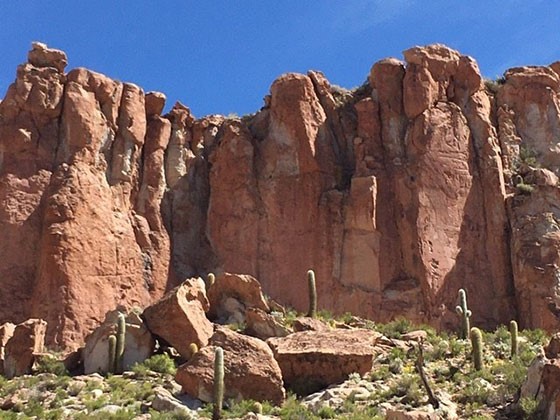 The sheer stone wall surrounding the mesa
The sheer stone wall surrounding the mesa
‘There is a secret path. But nobody remembers where it is,’ said our foreman.
We had twice tried to find a way up onto the top. Twice, we had failed. But Martha, the ranch cook, remembered that her uncle, who raised goats in the area, had shown her the ‘secret stairway’ many years ago.
So, on Saturday, we set off.
Island in the sky
The volcano Galán is only about 50 miles away. Geologists say that the pool of hot lava under the volcano leaked over here and pushed up the mesa. Millions of years ago, of course.
As unlikely as it seems, something extraordinary created the mesa. Pena Punta, it is called. It rises up out of the surrounding desert like Masada in Israel, where Herod the Great built his palaces, and the Jews — under attack by the Romans — committed mass suicide in 73 AD.
Mesas…or ‘table mountains’…are flat on the top. They can be small…or huge. Low…or hundreds of feet up.
One of the biggest and most intriguing is Roraima in Venezuela. So remote, so big, and so high above the jungle floor, hidden by hanging clouds, and protected by high cliffs, it has its own climate. And it has been separated from the rest of the country for so long, it has its own species of plants and animals.
Back in the 18th century, Roraima excited imaginations. People speculated about what strange wonders might be there. One of them, Arthur Conan Doyle, in his book, The Lost World, thought there might be dinosaurs still living there.
Pena Punta is not that big, nor that high. Shaped a bit like a long, curved island in the sky, it appears to be barren on top. It is about two miles long, and only about 300 feet wide at the center.
No way up
The air was crisp on Saturday morning. Our horses were sluggish. Your editor and his wife rode out the front gates, across the valley, and then down a steep, rocky path. One of the horses didn’t appreciate the trail. We had to dismount and lead him down.
Martha took a faster route, riding a motorcycle across the desert to where the land turned rugged. There, she left her motorcycle…and went on foot, sure and swift, over the rocks to the base of the mesa.
Martha lives in a puesto (an outpost) further up into the mountains. Most of the year, she herds goats and sheep, high in the crooks and crannies of the Andes.
She led us around the side of the mesa and up to the vertical wall. We remembered it from our last attempt. Red cliffs rise like the outer walls of a fortress. Looking closely, we saw no plausible way up.
After a half-hour or so, we came to some stones arranged in semi-circles, designed to hold earth and water in place so that crops could be grown. They are relics of not just another culture and another epoch, but also another climate. Now, it is much too dry to grow anything in these ‘terraced’ hills.
We tied up the horses inside the terraced area. Martha pointed up at the cliff.
‘It’s up there…I think.’
All three of us climbed up the rocks, probably about 200 vertical feet, to get to the base of the cliff. It was hard going, but not as hard as what lay ahead.
Rock-climbing
Martha halted at the rock face as we straggled up behind her, panting heavily.
She looked puzzled.
‘I thought it was here. But I don’t see it.’
There was no visible path…no signs of human feet…Perhaps they had just eroded away? Maybe the rocks had fallen?
Your editor spotted a possibility. He could pull himself up onto one rock…and then, Spiderman-like, edge across the face of the cliff to where some tumbled rocks gave him more of a footing. From there, he might have a clear shot at the top.
‘No…that’s not it,’ said Martha. But your editor was already engaged, carefully looking for footholds and handholds. The trouble was that the cliff face was not stable. He grabbed a rock, only to have it break off and fall to the ground.
‘Watch out,’ he yelled.
After a few minutes of climbing, he saw his error. He could climb up. But it would be a lot harder to go down.
‘Don’t try to follow me,’ he cautioned Elizabeth.
‘Don’t worry,’ she yelled back, in a tone that told us that she thought your editor was doing something stupid and that she had no intention of imitating him.
The same thought crossed his mind, too.
‘What the heck am I doing?’ he asked himself, as he realized he was in over his head.
But he was already halfway up. He continued, carefully placing his feet on the available ledges…holding on to the rocks above…
And finally, he scrambled up to the top.
On top of the mesa
There, he found himself on a strange, flattish, bone-dry surface…worn by millennia of wind and weather…Here and there was a dried-out bush…a delicate flower…or a clump of cactus. There were also ridges and gutters worn in the rock…some squared off, almost as if by human hands.
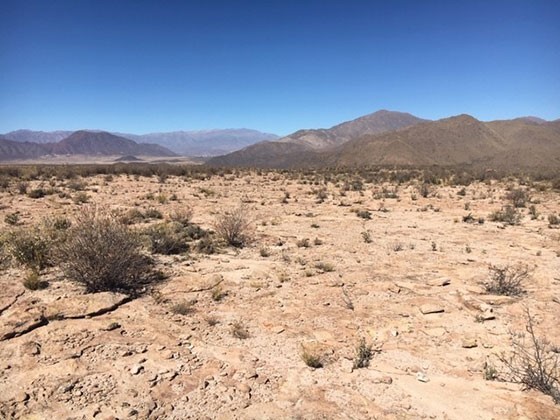 On top of the mesa
On top of the mesa
Alone in this deserted world, he looked back at where he had come up. He wasn’t sure it was safe to go down the same way, but he had no choice.
He decided he would worry about it later. For the moment, he just needed to fix in his mind the look of it…a landmark…so he could find the spot again.
This accomplished, he began exploring, with a light heart and an easy step. The land sloped gently to the east. He followed the slope…looking at the ground…looking for something, but not sure what.
There were odd rocks…and huge boulders lifted up, as if on display. The whole mesa must have been elevated on a huge piston of molten lava.
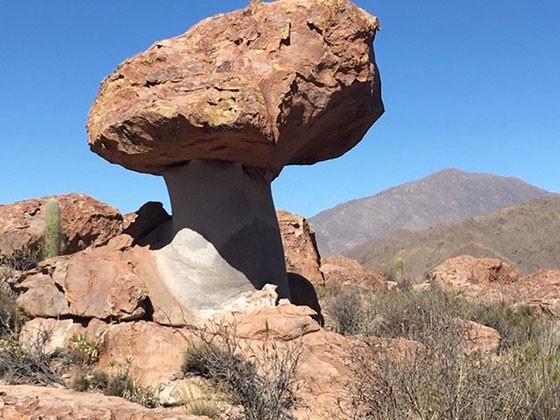 Some strange shapes awaited
Some strange shapes awaited
Stone circle
It was the ruins he had come to see. They were said to be in the center. So he directed himself thither.
But the mesa was bigger than he thought. He kept following the northern rim…still on a downward slope…And then, there was…suddenly…a row of rocks.
But this was not a terrace. This was a circle. What was it for? Ceremonial purposes? That’s what archeologists always say when they don’t understand what use a place might have served. (Some day, the ruins of Las Vegas will probably be identified as a religious center; it will be impossible to imagine people going to such an inhospitable place for entertainment.)
The walls of the circle were too low — barely a single course of stone — to be a house…Maybe rainwater was somehow directed into it so that something could grow. But it was scarcely 12 feet across. Not much growing room.
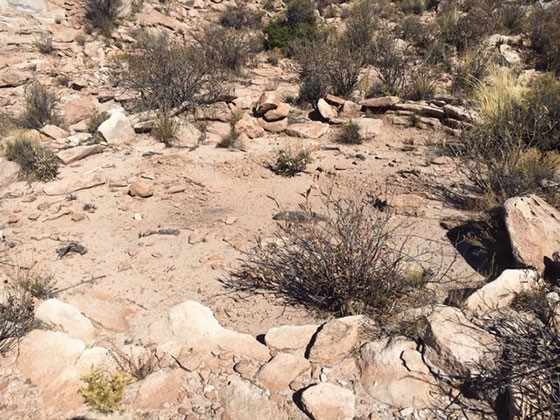 A stone circle
A stone circle
Further down, a shallow depression funneled what little rain there is off the edge of the cliff. There, the Indians had built the more familiar terraces. But they were so small…and the rain must have been so meager…What was the point? we wondered.
Discoveries
Wandering around further, we crossed over to the other side of the mesa. This time, we studied the lay of the land, following the drainage and guessing that the ruins would be near the lowest point, where ancient people might have captured as much water as possible.
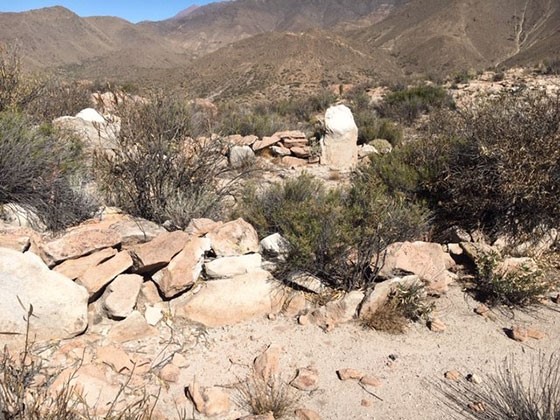 One tiny field leads to another
One tiny field leads to another
There, we found a more extensive group of retaining walls…one leading to another, as we followed the likely course of runoff. There, we discovered a mortero for milling grains…
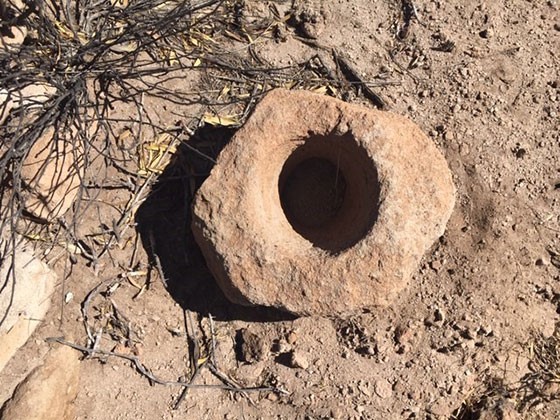 A mortero for milling grains
A mortero for milling grains
…and something that looked like a child’s tomb…or maybe just a place for storing food…There, too, were bigger piles of rocks; they must have been a wall that fell over.
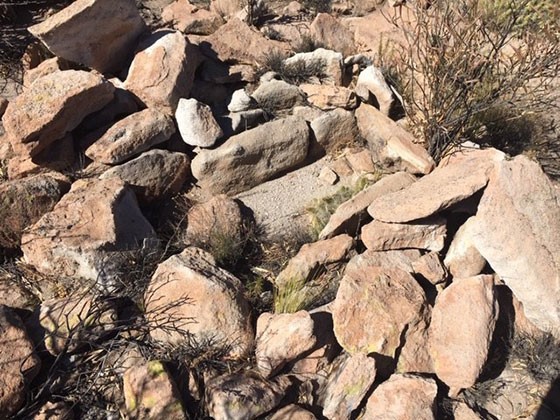 The tomb?
The tomb?
Last stronghold
At one time, there were trees growing on the mesa. The remains of them — well-weathered stumps, as hard as the rocks around them — are still there. The Indians must have been able to build primitive shelters, partly under the overhanging rocks.
But we couldn’t imagine a permanent settlement there. The fields were tiny. Even hundreds of years ago, there was probably not a lot of water. And little game. And when the winds of winter blew across the unprotected mesa, it must have been painfully cold.
Most likely, it was a seasonal outpost, perhaps used as a place where the local tribe protected itself against its enemies. Perhaps they grew what little they could up there, and carried up more food and water…using the place as a castle keep…the last stronghold of a threatened people.
Local legend says that the Gualfines Indians made their last stand against the Spanish here in the 17th century. Like the Jews at Masada, they are supposed to have thrown themselves off the cliff rather than surrender.
The tribe was part of a larger group called the Pulares Indians, who, at the time of the Spanish invasion, had submitted to the Incas and had already, presumably, been nearly annihilated by smallpox and other White Man’s diseases. They spoke a variety of the Kakan language. Not much more is known about them. After the Spanish conquest, the survivors were dispersed to other regions. The tribe ceased to exist.
How to get back down
We had been exploring for two hours, leaving Elizabeth and Martha down below. We found a few arrowheads (they were easy to spot; there is no flint up on top of the mesa and the black stone stands out against the reddish sand). We also found a red sandstone ball, about the size of a golf ball. What it was for, we don’t know…but it has a smooth side, rubbed by human hands.
It was time to go back down. But by then, we had been distracted by the ruins…Had we lost our bearings? We crossed to the other side and began looking for the landmarks we remembered, heading west along the rim.
After a while, we became nervous. Where were they? Where did we come up? Had we gone too far and missed them?
Elizabeth and Martha were still somewhere down below. We edged over to the rim…lying down so we could get as close to the sheer edge as possible without falling over.
‘Hell-Ooo’ we yelled.
No reply.
‘Hmm…Maybe we’re just way off. Or maybe the sound is lost in the wind.’
After a few more minutes, we decided that we had gone too far. We knew we were on the right side…and vaguely in the right place, for we could see the dry river bed down below, where we had approached the mesa. But there was about a mile of cliffside in that area, and it was all beginning to look alike.
We tried calling again.
‘Hello…Hello…Anybody there?’
Again, no reply.
The sun was already ebbing lower. We had left our heavy coat down below in order to make the climb easier. And now, a chill wind was picking up.
We needed to find where we came up…and get back down.
But the image of the landmark was getting muddled in our mind. It looked a little like the guard tower on the edge of a castle. Or was it more like a teapot? Or more like a stone outhouse?
We had seen dozens of landmarks. Each was different. And each was distressingly similar.
Hmmm…how to get down?
Rescue
It was in this agitated state of mind that we saw two figures approaching in the distance. How did they get up here?
‘Martha found the secret path,’ Elizabeth announced as we drew near. ‘It’s easy. But it’s well hidden.’
‘Great…Let me show you the ruins…and then, we better head back down the trail.’
Martha had brought a backpack with water and some dry sausages. We sat down amidst the ruins and had a little snack. The air was chilly, but the sun was still warm on our faces. Then, as we were getting ready to leave…
‘Let’s leave a little for the gods and the ghosts,’ said Martha, putting a bit of sausage on a rock.
Then, we made our descent.
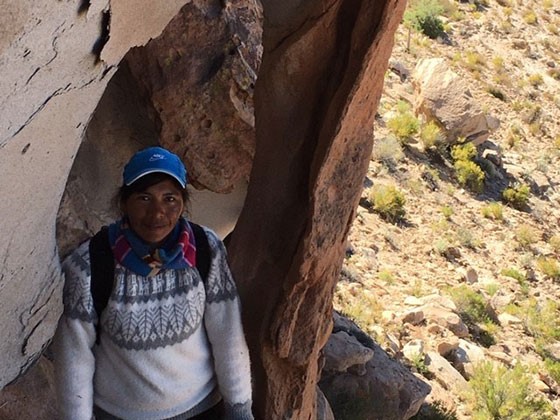 Martha, our guide, on the ‘secret stairway’
Martha, our guide, on the ‘secret stairway’
Stay tuned…
Regards,





Since founding Agora Inc. in 1979, Bill Bonner has found success and garnered camaraderie in numerous communities and industries. A man of many talents, his entrepreneurial savvy, unique writings, philanthropic undertakings, and preservationist activities have all been recognized and awarded by some of America’s most respected authorities. Along with Addison Wiggin, his friend and colleague, Bill has written two New York Times best-selling books, Financial Reckoning Day and Empire of Debt. Both works have been critically acclaimed internationally. With political journalist Lila Rajiva, he wrote his third New York Times best-selling book, Mobs, Messiahs and Markets, which offers concrete advice on how to avoid the public spectacle of modern finance.